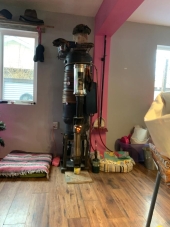I stumbled across this forum while researching rocket stoves, this is a great place. By combining a lot of ideas here and elsewhere, I've made a outdoor wood furnace that works on the rocket stove principle. This is the second year I've used it and in that time it has changed a lot. I've managed to build a feed system that keeps the fire going with no attending to for up to 8 hours. It currently heats my home and water, and in the future, I'd like it to produce the electricity to run the heat reclaimer. I'm currently using a 15W solar panel for that, but have been less than pleased with its performance. Here's some videos that I've made of my most recent modifications:
The heat reclaimer which takes the heat that is conducted from the feed tube, turns it into hot air, and feeds it through the firewood. This preheats the fuel and provides preheated air for combustion.
This is how I prepare the wood for the fire. I've actually modified what I do a bit since I made the video. I now only use 2 loops to hold the wood and changed to a easier knot to tie. I'd like to find something beside baling twine, but it was what I had on hand. Temperature is adjusted by the size of the wood fed into it. Feed a bundle of kindling into it and you'll pop the safety valve. Feed a bundle with larger logs, and you'll maintain a nice even temperature.
Thanks to the many people here that have shared their projects - you were all an inspiration to me

**EDIT**
Here's a picture of the system on the outside for those without a high speed connection:
On the right, you have the feed tube made from 8" black stove pipe. It feeds the wood vertically into the insulated burn chamber. Heat conducted from the feed tube is captured by the heat reclaimer (the galvanized portion at the bottom). It preheats the combustion air which is forced past all the wood in the feed tube. This preheats the fuel as well. The flame goes horizontal for 2 feet in the insulated heat riser. There is 4" thick refractory cast around the burn chamber and heat riser. There is another 4" of concrete poured around that.
From there, the heat riser turns vertical and extends another 2 feet. By the end of the heat riser, the flame stops and all smoke has burned. This is where 110 feet of copper tubing is coiled inside. 50' of 1/2" pipe first, then 60' of 3/8" last. To capture as much heat as possible, I run the water from top to bottom. The exhaust is cool enough to hold your hand in front of, kind of like a dryer vent in temperature. Once the stove has come up to operating temperature, all smoke disappears and you can no longer even tell that wood is burning by the smell.
The water exits the bottom at 150 to 200 degrees, depending on the size of the fuel fed. By burning smaller wood, you raise the output. Larger pieces lower the output. It is quite easy to keep an even temperature by simply adjusting the size of wood being burned to correspond with the time of the day. To prevent disaster, there is a T&P valve at the bottom that pops off at 210 degrees. It is then pumped into my house where it is fed through a 18"x18" exchanger where it is turned into hot air. The cool side is then pumped into my hot water heater. This provides water hot enough for most daily tasks. If hotter water is needed, the blower can be shut down for 5 minutes to heat the water to 150. In the future, I'm going to install a different snap switch that will do this for me.
The water is then pumped back to the heater where the cycle starts all over again. If you have any further questions, I'd be glad to answer them. It is a pretty simple system.

 3
3














 You can really put out some heat in that amount of time, on average I produce 384000 BTU in 7 hours to maintain 70 degrees and hot water. I'd love to have gone with a thermal mass setup, but I live in a doublewide, so I had to go hydronic.
You can really put out some heat in that amount of time, on average I produce 384000 BTU in 7 hours to maintain 70 degrees and hot water. I'd love to have gone with a thermal mass setup, but I live in a doublewide, so I had to go hydronic.





















 1
1

















































